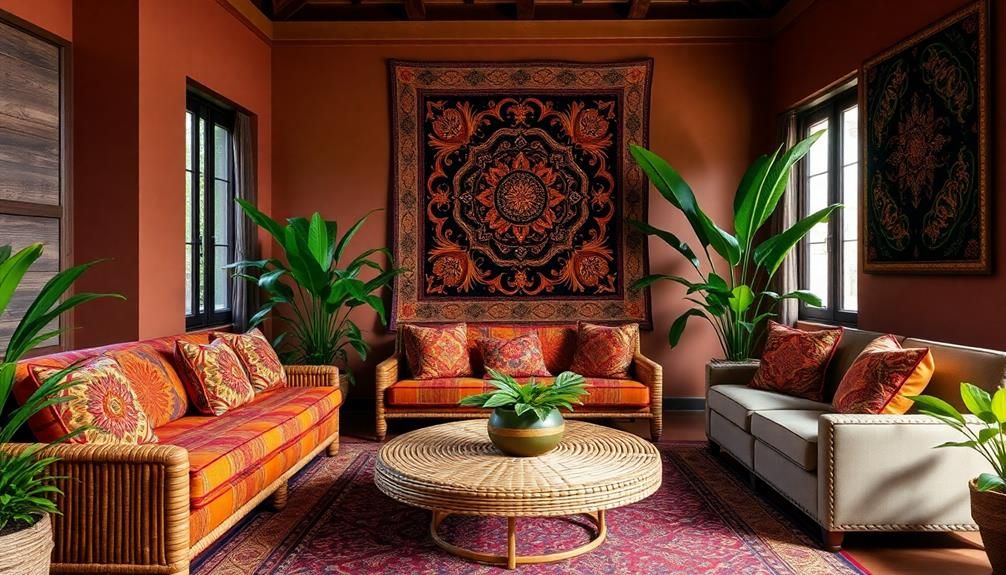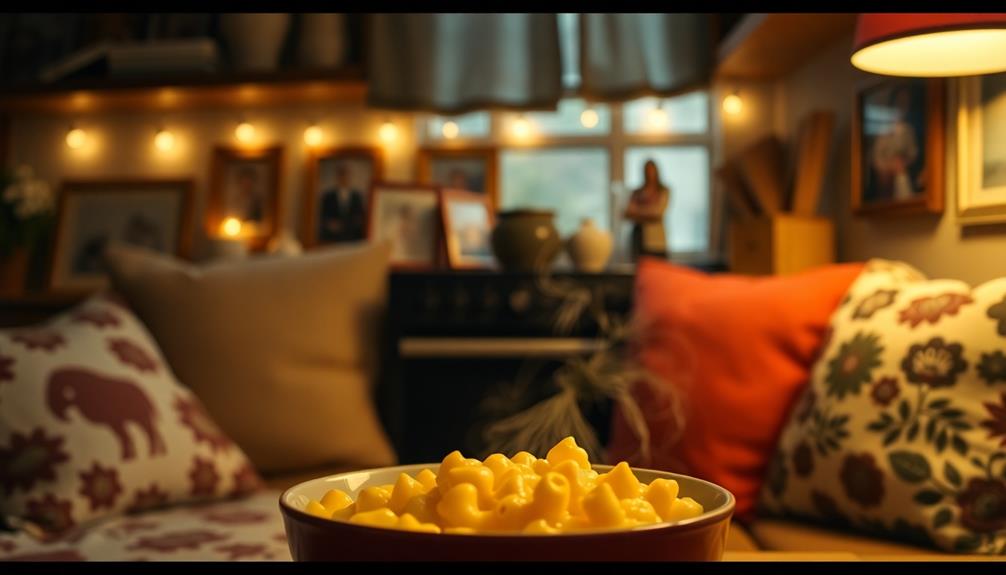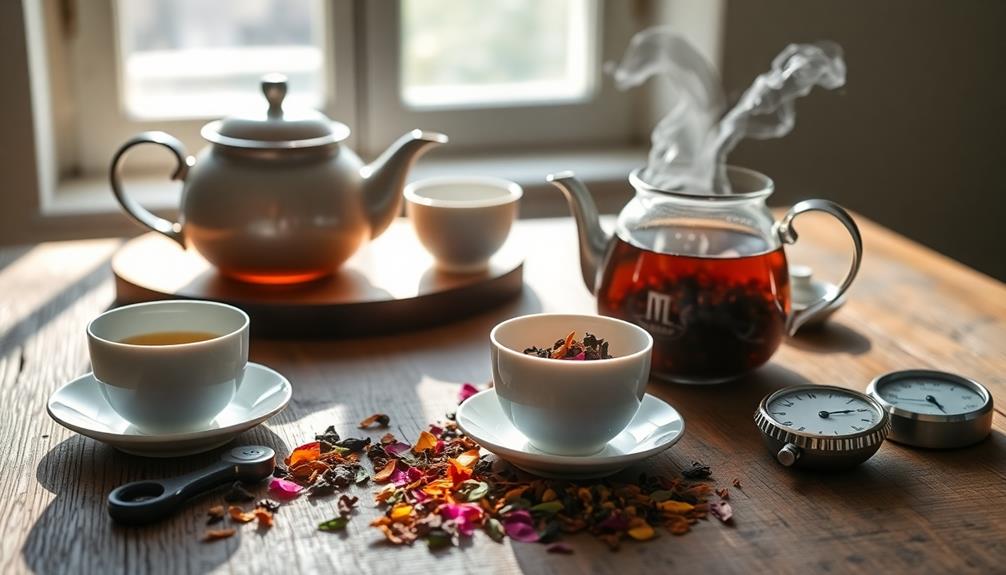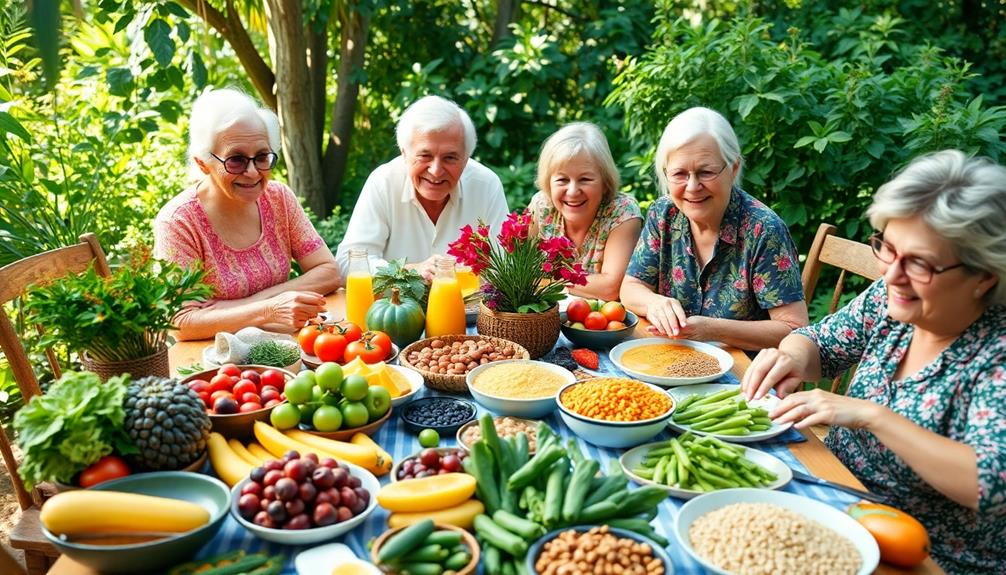Indonesian fabrics are taking the modern interior design world by storm, and you can see why. Their vibrant colors and intricate designs, especially batik, add cultural richness to any space. Rattan furniture, with its durability and versatility, blends seamlessly with various styles, while wayang puppets and wood carvings enhance decor with storytelling elements. These textiles not only serve aesthetic purposes but also promote sustainability through eco-friendly production methods. By incorporating these unique fabrics, you can create stunning, contemporary spaces that celebrate heritage. Stick around to uncover more design tips and insights on utilizing Indonesian fabrics in your home.
Key Takeaways
- Indonesian fabrics like batik and rattan enhance modern interior design with their vibrant colors, intricate patterns, and sustainable craftsmanship.
- The UNESCO recognition of batik has boosted its global appeal, integrating cultural motifs into contemporary decor.
- Rattan's versatility and durability make it a favored choice for stylish, weather-resistant furniture in both indoor and outdoor settings.
- Collaborations between local artisans and designers promote sustainable practices, blending traditional techniques with modern aesthetics for unique textile applications.
- Incorporating wayang puppets as decor adds cultural richness and creates striking focal points within modern interior spaces.
Overview of Indonesian Fabrics
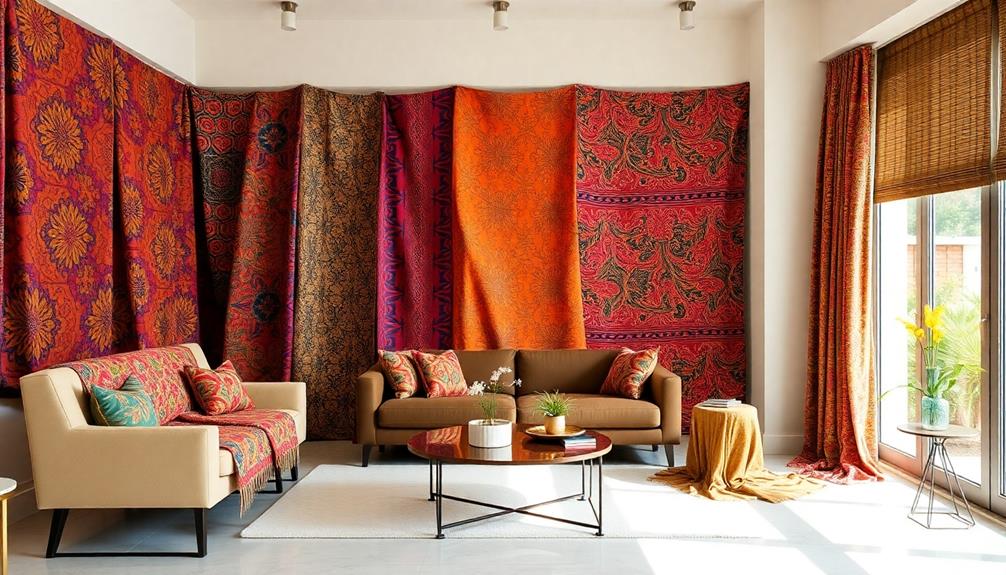
When you explore Indonesian fabrics, you'll find a vibrant tapestry of cultural heritage and craftsmanship. Among these, batik stands out as a quintessential textile, renowned for its intricate designs and labor-intensive wax-resist dyeing technique. Each piece tells a story through traditional motifs that reflect the diverse Indonesian culture, showcasing the unique identities of various regions.
The use of Indonesian decor masks alongside these textiles further amplifies the rich artistry and heritage in interior design, as masks serve as decorative pieces that enhance aesthetic appeal.
Textile makers skillfully create these stunning patterns, making batik a popular choice for modern home decor items like upholstery and curtains. As you investigate deeper, you'll discover other remarkable materials, such as rattan, celebrated for its durability and versatility. Rattan is ideal for both indoor and outdoor furniture, and Indonesia is the world's largest producer and exporter of this natural resource.
Additionally, the integration of wood carvings into textiles adds another layer of traditional craftsmanship to contemporary interiors. Designs inspired by tribes like the Balinese and Dayak highlight the rich artistic history of the region.
With the rising global demand for authentic, handcrafted textiles, Indonesian fabrics are becoming essential in modern design, enhancing aesthetic appeal and creating unique focal points in homes.
The Allure of Batik
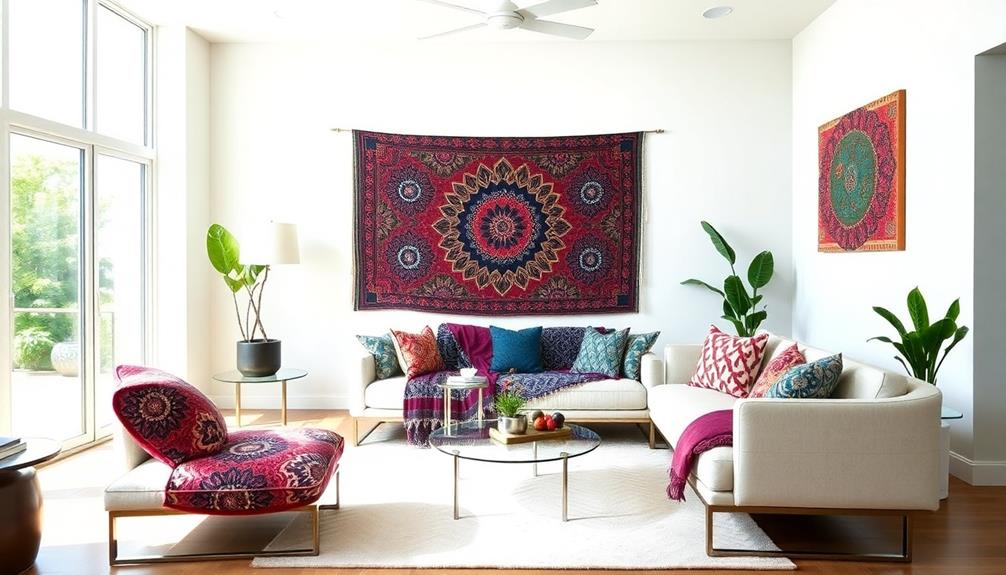
Batik captivates with its stunning artistry and rich cultural significance, making it a favored choice in interior design. This ancient Indonesian textile art form employs a labor-intensive wax-resist dyeing technique, resulting in intricate patterns that reflect local culture and nature. You'll find that contemporary batik designs seamlessly blend with various aesthetics, enhancing both traditional and modern interiors.
| Feature | Description | Application |
|---|---|---|
| Patterns | Intricate designs showcasing cultural heritage | Upholstery and throw pillows |
| Color Palette | Vibrant hues that brighten any space | Decorative wall panels |
| Sustainability | Handcrafted, promoting sustainable living | Eco-friendly decor choices |
Since UNESCO recognized Indonesian batik as an Intangible Cultural Heritage of Humanity in 2009, its significance has only grown. The demand for authentic batik textiles reflects a global interest in sustainable and handcrafted products. By incorporating batik into your home, you not only add a unique design element but also celebrate a rich cultural heritage that resonates with many.
Rattan's Versatility in Design

Rattan is a game changer in interior design, thanks to its remarkable versatility and natural charm. This highly adaptable material is perfect for various applications, whether you're looking for furniture, baskets, or mats. Sourced primarily from Cirebon in West Java, Indonesia is the world's largest rattan producer, contributing to its global appeal.
Balinese design characteristics often highlight the use of natural materials, making rattan an ideal choice for creating a harmonious environment that connects indoor and outdoor spaces.
You'll find rattan furniture is especially popular for outdoor settings due to its durability and weather resistance. It can withstand different environmental conditions while maintaining its aesthetic appeal. As a result, rattan products have become luxury items in markets like Europe, the USA, and Japan, showcasing their desirability in modern interior design.
The unique textures and natural hues of rattan allow you to seamlessly integrate it into various design styles, from bohemian to contemporary.
Whether you're furnishing a cozy living room or an inviting patio, rattan's versatility enhances the overall visual appeal of your spaces. Embracing rattan in your design choices not only elevates your interiors but also connects you to the rich craftsmanship of Indonesian artistry.
Wayang Puppets as Decor
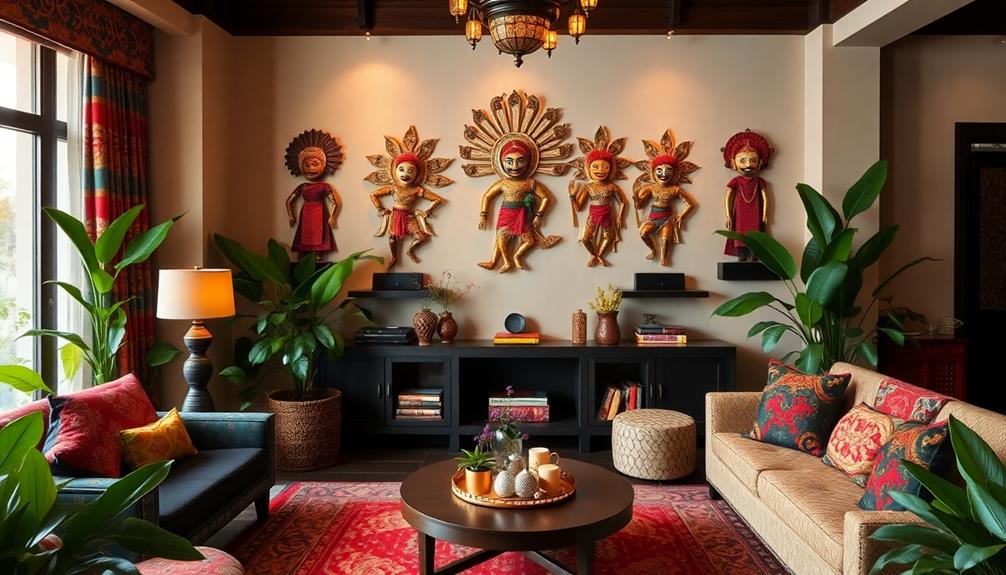
Incorporating cultural elements like Wayang puppets into your home can bring a distinctive flair to your interior design. Originating from Java, these puppets, with their intricate craftsmanship and vibrant colors, serve as more than just decorative elements; they embody Indonesia's rich cultural heritage and encourage appreciation for traditional craftsmanship.
Here are three ways you can use Wayang puppets to elevate your space:
- Wall Art: Hang a collection of Wayang puppets on your wall. Their detailed designs create a stunning focal point that draws attention.
- Sculptural Displays: Use Wayang Kulit or Wayang Golek figurines as centerpieces on tables or shelves. These pieces not only showcase artistry but also spark engaging conversations.
- Themed Corners: Create a dedicated space in your home featuring Wayang puppets alongside other Indonesian decor, like Indonesian decor masks. This can transport your guests to a world of cultural richness.
Wood Carvings and Cultural Significance
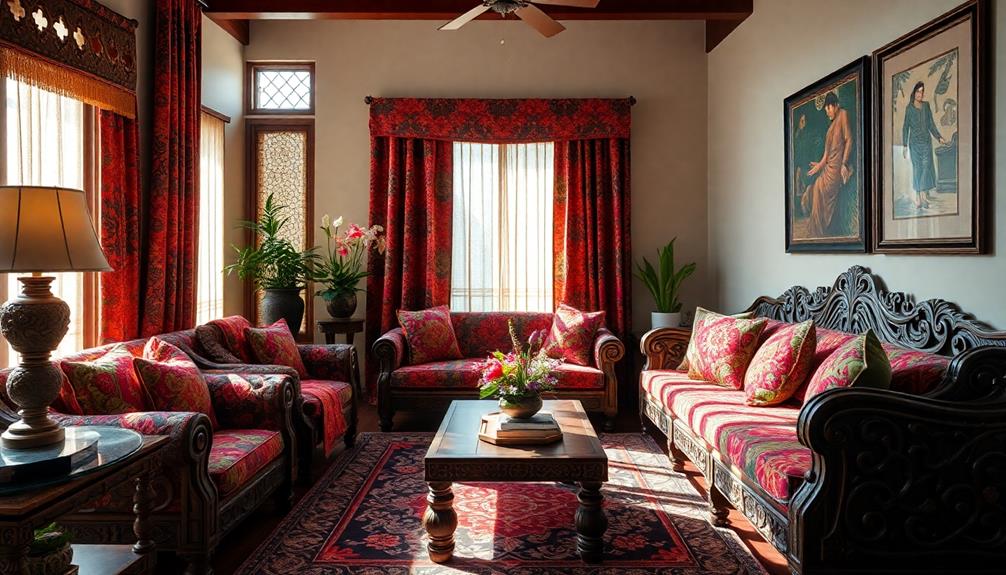
When you explore Indonesian wood carvings, you're stepping into a world rich with history and craftsmanship.
These pieces not only showcase intricate techniques but also tell stories that reflect cultural beliefs and traditions.
Often, these carvings are complemented by traditional textiles, such as Batik and Ikat, which enhance their visual appeal and connect them to the broader spectrum of Indonesian decorative elements.
Historical Context and Techniques
Wood carvings in Indonesia are more than just artistic expressions; they embody the rich cultural heritage and spiritual beliefs of various tribal groups, such as the Dayak, Asmat, and Balinese peoples.
These intricate carvings date back to the 13th century and showcase a traditional way of making art that integrates mythology, nature, and religious themes. Additionally, the importance of Indonesian decor masks in representing cultural storytelling further emphasizes the significance of these handcrafted items.
Here are three key aspects of Indonesian wood carving:
- Cultural Significance: Each piece reflects the cultural heritage of humanity, telling stories and preserving traditions.
- Craftsmanship: Artisans hand-carve detailed designs, ensuring that every item is unique and tells its own story.
- Contemporary Use: These carvings have evolved from religious and ceremonial items to modern design elements, enriching luxurious homes and hotels worldwide.
As you explore the world of Indonesian batik, you'll find that wood carvings complement these textiles beautifully, creating a cohesive aesthetic that celebrates both tradition and modernity.
The growing demand for these authentic, handcrafted products highlights their importance in today's global markets, making them essential components of modern interior design.
Artistic Expression and Symbolism
Indonesian wood carvings serve not just as decorative elements but as profound artistic expressions that encapsulate the cultural narratives of their creators. These intricate art forms, rooted in tribal cultures like those of the Dayak, Asmat, and Balinese tribes, date back to the 13th century.
Each carving tells a story, incorporating batik motifs and symbols that reflect the rich cultural heritage of Indonesia. Additionally, the use of local artisans in creating these pieces enhances their authenticity and connection to Bali's distinctive design culture, as seen in expert tropical design.
As you integrate these carvings into your space, you're not just adding unique sculptures or wall art; you're embracing a design aesthetic that honors tradition. These pieces often serve practical purposes, such as headboards, allowing you to enjoy functional art that resonates with deep cultural significance.
Since the 1930s, these wood carvings have found a place in luxurious homes and hotels worldwide, showcasing their universal appeal. By choosing such artisanal products, you're supporting local economies and preserving the craftsmanship that defines Indonesian artistry.
Blending Tradition With Modernity

When you incorporate Indonesian fabrics like batik into your interior design, you're not just adding color; you're honoring a rich cultural heritage.
These fabrics can also be used in various decor elements, from throw pillows to wall art, to create a cohesive look that reflects your personal style.
Modern innovations in fabric design make it easy to blend these traditional patterns with sleek, contemporary aesthetics.
Plus, embracing sustainable craftsmanship practices means you're supporting artisans while creating a unique, stylish space.
Consider incorporating Indonesian Wedding Decor Ideas to inspire your design choices.
Cultural Heritage in Design
Blending tradition with modernity in interior design offers a fresh perspective on cultural heritage, and few elements exemplify this fusion as beautifully as batik. This Indonesian fabric brings a rich history into your living spaces, enhancing design aesthetics while honoring its heritage.
The use of batik aligns with the increasing appreciation for sustainable materials in contemporary design, reflecting a commitment to both culture and the environment.
Here are three ways to incorporate batik into your interiors:
- Accent Pieces: Use batik patterns in cushions or throws. These vibrant textiles add a pop of color and an element of cultural storytelling.
- Wall Art: Batik can transform your walls. Framed pieces or wall hangings showcase intricate designs that celebrate tradition while fitting into modern decor.
- Curtains and Drapes: Consider batik for window treatments. The fabric's versatility allows it to harmonize with various styles, creating a unique ambiance.
With UNESCO's recognition of batik as an Intangible Cultural Heritage, its integration into contemporary design reflects a growing appreciation for authentic, handcrafted textiles.
Collaborations between local artisans and designers guarantee that batik evolves while remaining rooted in its origins.
Embrace this blend of heritage and modernity, and watch your space come alive with the spirit of Indonesia.
Modern Fabric Innovations
Harnessing the beauty of traditional techniques, modern fabric innovations are redefining the role of textiles in interior design. Designers are creatively blending batik patterns and ikat with contemporary styles, resulting in unique textiles that resonate with global markets.
This fusion not only highlights the rich cultural heritage of Indonesia but also appeals to modern sensibilities, making it a key aspect of traditional Indonesian style home decor. You'll notice how these innovative fabrics are transforming living spaces, as they're repurposed into versatile items like cushions, curtains, and wall hangings.
The collaborations between skilled artisans and modern designers have birthed hybrid textiles that merge traditional motifs with sleek aesthetics, making them perfect for various interior styles.
As consumer demand for eco-friendly products rises, these modern fabric innovations are increasingly incorporating sustainable practices, like organic dyes and recycled fibers. This shift reflects a commitment to both style and the environment, ensuring that your choices in home decor aren't just beautiful but also responsible.
The international popularity of Indonesian fabrics has soared, with luxury brands proudly showcasing these textiles in their collections, further elevating their status in the global design landscape.
Sustainable Craftsmanship Practices
In the domain of Indonesian textiles, sustainable craftsmanship practices are gaining momentum as artisans merge traditional techniques with modern eco-friendly methods.
This movement is reminiscent of the approach taken by luxury interior design firms like Mahallati Interiors, which emphasize the use of natural materials to create inviting spaces.
You'll find that this blend not only preserves the rich heritage of textiles but also addresses contemporary environmental concerns.
Here are three ways this movement is shaping the industry:
- Organic Dyes: Artisans are increasingly using organic dyes derived from natural sources, reducing harmful chemical usage and ensuring a minimal environmental footprint.
- Eco-Friendly Materials: The revival of traditional batik involves the use of recycled textiles and natural fibers, promoting sustainability while maintaining cultural significance.
- Collaborative Designs: Local artisans are teaming up with international designers to create unique pieces that highlight sustainable craftsmanship, appealing to a market that values eco-conscious choices.
Through these practices, Indonesian artisans aren't just creating beautiful fabrics; they're fostering a deeper appreciation for their cultural significance in modern design.
This commitment to sustainability not only supports local economies but also resonates with those who cherish responsible fashion and timeless artistry.
Embrace these stunning textiles, and you'll be contributing to a more sustainable future.
Sustainable Practices in Fabric Production
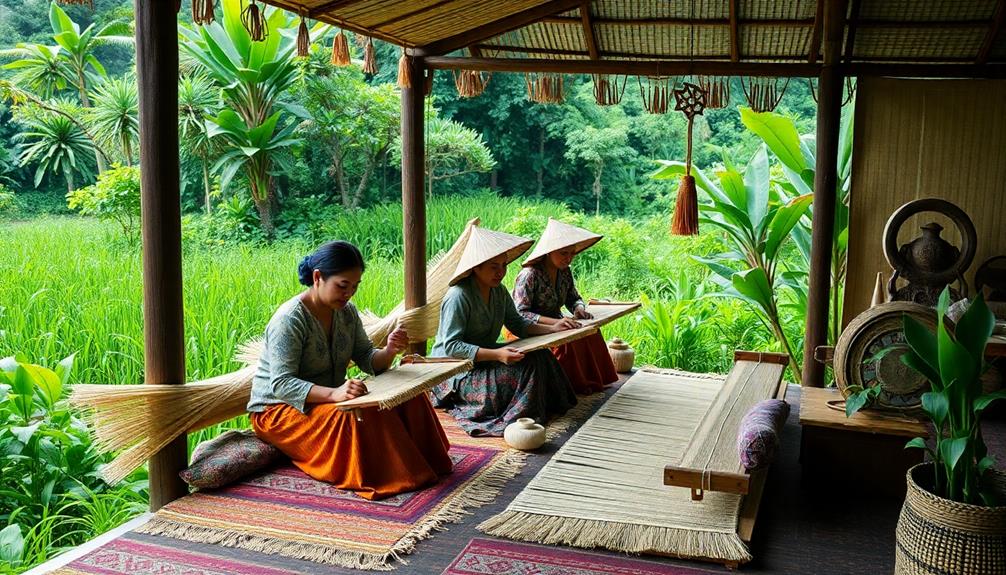
Sustainable practices in Indonesian fabric production are gaining momentum, with many artisans shifting towards eco-friendly methods that considerably reduce environmental impact.
You'll find that numerous batik producers are embracing traditional craftsmanship techniques that prioritize sustainability, ensuring their production processes respect both the environment and cultural heritage.
Brands like BINhouse Indonesian Creation play an essential role in this movement by supporting local artisans. They create economic opportunities while championing sustainable practices in textile manufacturing.
You can also see the revival of batik incorporating recycled textiles and sustainable materials like cotton, linen, and Tencel, making it appealing to eco-conscious consumers like you.
Moreover, government initiatives and partnerships with educational institutions are fostering sustainable practices in fabric production.
These efforts encourage younger generations to adopt environmentally friendly techniques, ensuring a brighter future for the industry.
By choosing fabrics made with organic dyes and eco-friendly materials, you're not just decorating your space; you're also making a statement in support of sustainable development.
This shift not only enhances your interior design but also contributes to a more responsible and eco-friendly world.
Global Trends Influencing Indonesian Fabrics

You're seeing a revival of cultural heritage that's shaping the way Indonesian fabrics are viewed globally.
As sustainable design practices gain traction, people are drawn to the authentic, eco-friendly textiles that reflect rich traditions.
Plus, the integration of these fabrics into global fashion trends highlights their versatility and appeal in modern interiors.
Cultural Heritage Revival
Cultural heritage revival is reshaping the landscape of interior design, and Indonesian fabrics, especially batik, are at the forefront of this movement.
As you explore modern aesthetics, you'll notice how designers are embracing the rich cultural significance of these textiles. This trend highlights the importance of preserving traditional art forms while making them relevant today.
Here are three key aspects of this cultural heritage revival:
1. UNESCO's Recognition: The acknowledgment of batik as an Intangible Cultural Heritage has greatly boosted its global appeal, making it a sought-after element in interior design.
2. Local Motifs: Designers are skillfully incorporating intricate batik designs into various modern decor styles, blending tradition with contemporary flair.
This fusion creates a unique visual narrative that enhances any space.
3. Artisan Collaborations: Exhibitions and partnerships between Indonesian artisans and international designers have elevated the status of these textiles, showcasing their versatility and beauty.
Sustainable Design Practices
The shift toward eco-consciousness in design is transforming the fabric landscape, and Indonesian textiles are embracing this change with vigor.
You'll find that sustainable practices are at the forefront of this movement, with artisans increasingly utilizing eco-friendly materials. By incorporating traditional techniques, they minimize waste and harness renewable resources, greatly enhancing the cultural significance of their craft.
As you explore the rise of slow fashion, it's clear that consumers prefer handcrafted textiles, and Indonesian fabrics are perfectly positioned to meet this demand.
These textiles reflect a commitment to sustainability and craftsmanship that resonates with eco-aware buyers. Furthermore, global collaborations between Indonesian producers and international designers are fostering innovative techniques aimed at reducing environmental impact.
As you navigate through choices in interior design, you'll notice a growing emphasis on transparency in sourcing and production.
Indonesian manufacturers are responding to this demand by highlighting their dedication to sustainable practices and preserving local craftsmanship.
Global Fashion Integration
As sustainable design practices continue to shape the fabric industry, Indonesian textiles are increasingly making their mark on the global fashion scene. Designers from Europe and the United States are now incorporating traditional batik motifs and techniques into modern collections, creating a unique blend of cultural heritage and contemporary style.
This integration highlights the versatility of Indonesian materials, inspiring a diverse audience.
Consider these key influences driving the global fashion integration of Indonesian fabrics:
- High-profile collaborations: Designers like Diane von Furstenberg have showcased batik-inspired pieces, elevating the status of Indonesian textiles in global fashion.
- Social media impact: Platforms promote Indonesian fabrics, capturing the attention of younger consumers who crave unique and culturally rich designs.
- Exhibitions and events: Shows like Batik Kita merge historical and contemporary batik, illustrating the evolving narrative of Indonesian fabrics on the world stage.
These elements not only enhance the appeal of batik but also emphasize sustainable practices, ensuring traditional craftsmanship resonates with modern markets.
Tips for Incorporating Indonesian Textiles
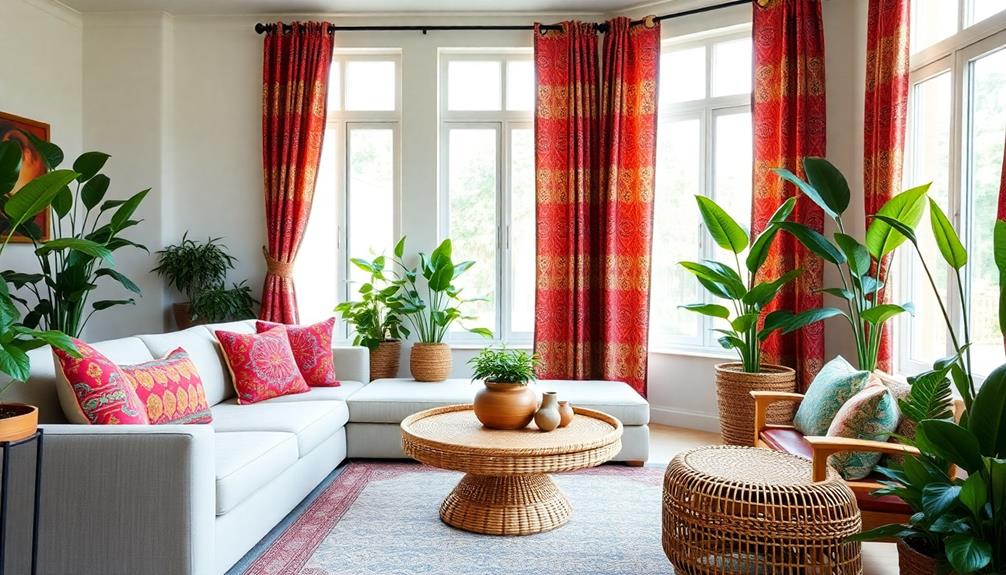
How can you seamlessly incorporate Indonesian textiles into your home? Start with vibrant batik fabric and traditional batik pieces as accent elements. Use them for cushions, curtains, or throws in modern bohemian spaces to infuse cultural significance and striking patterns into your interior design.
To achieve a cohesive look, pair these textiles with rattan furniture. The durability and weather resistance of rattan complement the decorative qualities of Indonesian fabrics beautifully.
When selecting your textiles, choose patterns that reflect local cultural motifs; these designs not only enhance your room's aesthetic but also serve as engaging conversation starters.
Mixing Indonesian textiles with solid colors is essential to avoid overwhelming your space. This balance allows the unique patterns to shine while maintaining an inviting atmosphere.
Additionally, consider incorporating wayang puppets as decorative wall art or sculpture pieces. They can further enrich your design scheme, layering cultural elements with your chosen fabrics.
The Future of Indonesian Fabrics in Design
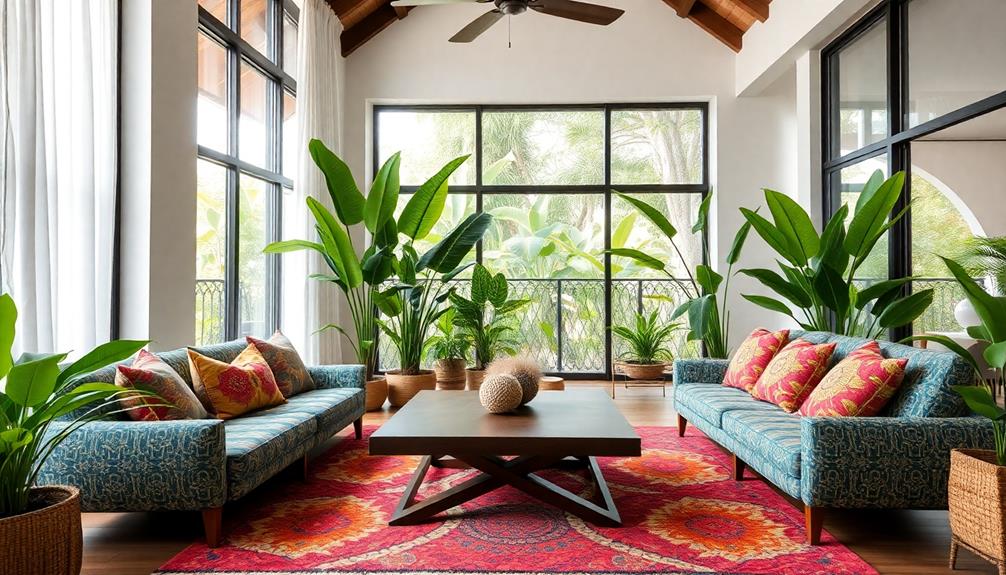
Increasingly, Indonesian fabrics are shaping the future of interior design, merging traditional craftsmanship with modern aesthetics. As you explore this evolving landscape, you'll find that these authentic, handcrafted materials are more than just beautiful; they embody a rich cultural heritage and sustainable practices that resonate with today's eco-conscious consumer.
Here are three key trends to watch:
- Collaboration with Artisans: Designers are working closely with local artisans to adapt traditional fabrics like batik for contemporary applications, ensuring that the unique stories behind each piece are preserved.
- Sustainable Production: The use of organic dyes and environmentally friendly methods is becoming essential. This commitment to sustainable practices attracts consumers who prioritize eco-conscious design in their homes.
- Versatile Applications: Indonesian fabrics are increasingly seen in luxury home décor items, from upholstery to wall art, showcasing their ability to enhance various design styles and appeal to diverse tastes.
As these fabrics gain recognition in international markets, their presence in high-profile exhibitions solidifies their role as a crucial element in the future of global interior design trends.
Embrace this evolution and let Indonesian fabrics elevate your space.
Frequently Asked Questions
What Are the Most Popular Indonesian Fabrics Used in Interior Design?
When exploring popular Indonesian fabrics for interior design, you'll find batik, ikat, and songket leading the way. These textiles add vibrant patterns and rich textures, enhancing your space with cultural depth and elegance.
How Do I Care for Indonesian Textiles in My Home?
To care for Indonesian textiles, regularly dust them and avoid direct sunlight to prevent fading. Hand wash or spot clean gently with mild soap, and always air dry to maintain their vibrant colors and integrity.
Where Can I Purchase Authentic Indonesian Fabrics?
You can purchase authentic Indonesian fabrics online through specialty retailers, artisan marketplaces, or directly from Indonesian artisans. Local craft fairs and cultural festivals also often showcase these textiles, offering a unique shopping experience.
Are Indonesian Fabrics Eco-Friendly and Ethically Sourced?
Yes, many Indonesian fabrics are eco-friendly and ethically sourced. You'll find artisans using sustainable practices, and local materials, ensuring the production process respects both the environment and the communities. Look for certifications to confirm their authenticity.
Can Indonesian Fabrics Be Used in Outdoor Spaces?
Picture vibrant Indonesian fabrics dancing in the breeze, adding color and texture to your outdoor spaces. They're durable and weather-resistant, making them perfect for patios or gardens, where beauty meets function effortlessly.
Conclusion
As you embrace the beauty of Indonesian fabrics in your home, think of the stories they tell—each piece a vibrant thread woven into the tapestry of culture and creativity. By incorporating these unique textiles, you're not just decorating; you're celebrating a rich heritage that's gaining momentum in modern design. So, why not let the allure of Batik, the charm of rattan, and the artistry of wood carvings inspire your next interior project? Your space deserves it!
